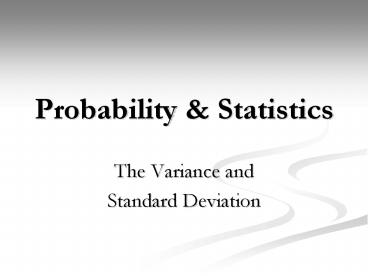Probability & Statistics The Variance and Standard Deviation - PowerPoint PPT Presentation
1 / 23
Title:
Probability & Statistics The Variance and Standard Deviation
Description:
Probability & Statistics The Variance and Standard Deviation The Most Important Number In the last section we looked at three related concepts: The mean of a sample ... – PowerPoint PPT presentation
Number of Views:212
Avg rating:3.0/5.0
Title: Probability & Statistics The Variance and Standard Deviation
1
Probability Statistics
- The Variance and
- Standard Deviation
2
The Most Important Number
- In the last section we looked at three related
concepts - The mean of a sample,
- The mean of a population, µ
- The mean or expected value of a random variable,
E(X) - The mean is probably the single most important
number that can be used to describe a sample,
population, or probability distribution of a
random variable.
x
3
The Second Most Important Number
- In this section, we learn about the next most
important number the variance. - Closely associated with the variance, and
oftentimes used more, is the standard deviation.
4
Spread
- Roughly speaking, the variance measures the
dispersal or spread of a distribution about its
mean. - The probability distribution whose histogram is
drawn on the left has a smaller variance than
that on the right.
5
Variance of Probability Distribution
Let X be a random variable with values x1, x2, ,
xN and respective probabilities p1, p2,, pN. The
variance of the probability distribution is
6
Standard Deviation of a Probability Distribution
The standard deviation of a probability
distribution is
7
Unbiased Estimate
- If the average of a statistic, given that the
statistic were computed for each sample, equals
the associated parameter for the population, then
that statistic is said to be unbiased.
8
Sample Variance and Standard Deviation
- The unbiased variance for a sample is
- The unbiased standard deviation for a sample is
9
Example 1
- Two golfers recorded their scores for 20
nine-hole rounds of golf. - a.) Compute the sample mean and the variance of
each golfers score. - b.) Who is the better golfer? (Note The lower
the score, the better.) - c.) Who is the more consistent golfer?
10
(No Transcript)
11
(No Transcript)
12
Alternative Definitions
- Two alternative definitions for variance are
- and, for a binomial random variable with
parameters n, p, and q,
13
Example 2
- Compute the variance and standard deviation of
the probability distribution in the table at
right.
14
(No Transcript)
15
Example 3
- Find the variance when a fair coin is tossed 5
times and X is the number of heads.
16
More Formulas for SampleVariance and Standard
Deviation (Use When Data Values Listed
Individually)
17
Example 4
- The table at right gives the number of books (in
millions) in the 10 largest public libraries in
the United States. - Determine the mean and the standard deviation
for the number of books.
18
(No Transcript)
19
Chebychev's Inequality
- Chebychev's Inequality
- Suppose that a probability distribution with
numerical outcomes has expected value and
standard deviation Then the probability
that a randomly chosen outcome lies between -
c and c is at least
20
Example 5
- A drug company sells bottles containing 100
capsules of penicillin. Due to bottling
procedure, not every bottle contains exactly 100
capsules. Assume that the average number of
capsules in a bottle is 100 and the standard
deviation is 2. If the company ships 5000
bottles, estimate the number of bottles having
between 95 and 105 capsules, inclusive.
21
Example 6
- An electronics firm determines that the number
of defective transistors in each batch averages
15 with standard deviation 10. Suppose that 100
batches are produced. - Estimate the number of batches having between 0
and 30 defective transistors.
22
Summary
- The variance of a random variable is the sum of
the products of the square of each outcome's
distance from the expected value and the
outcome's probability. - The variance of the random variable X can also be
computed as E(X 2) - E(X) 2. - A binomial random variable with parameters n and
p has expected value np and variance np(1 - p).
23
Summary
- The square root of the variance is called the
standard deviation. - Chebychev's Inequality states that the
probability that an outcome of an experiment is
within c units of the mean is at least
, where is the standard deviation.































